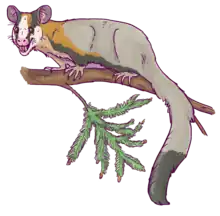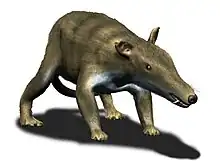| Peligrotherium | |
|---|---|
 | |
| Life restoration and 3D model of skull and mandibles | |
| Scientific classification | |
| Domain: | Eukaryota |
| Kingdom: | Animalia |
| Phylum: | Chordata |
| Class: | Mammalia |
| Clade: | †Meridiolestida |
| Clade: | †Mesungulatoidea |
| Family: | †Peligrotheriidae Bonaparte et al., 1993 |
| Genus: | †Peligrotherium Bonaparte et al., 1993 |
| Species: | †P. tropicalis |
| Binomial name | |
| †Peligrotherium tropicalis Bonaparte et al., 1993 | |
Peligrotherium is an extinct meridiolestidan mammal from the Paleocene of Patagonia, originally interpreted as a stem-ungulate (though it did co-exist with early meridiungulates). Its remains have been found in the Salamanca Formation.[1] It was a dog-sized mammal, among the largest of all non-therian mammals (as well as the largest South American Paleocene mammal[2]). It is a member of Mesungulatoidea, a clade of herbivorous meridiolestidans with molars that had rounded (bunodont) cusps.[3][4]
References
- ↑ Peligrotherium at Fossilworks.org
- ↑ Rougier, Guillermo, Martinelli, Agustin, Forasiepi, Analía M., Mesozoic Mammals from South America and their Forerunners, ISBN 978-3-030-63862-7
- ↑ Tony Harper; Ana Parras; Guillermo W. Rougier (2018). "Reigitherium (Meridiolestida, Mesungulatoidea) an enigmatic Late Cretaceous mammal from Patagonia, Argentina: morphology, affinities, and dental evolution". Journal of Mammalian Evolution. in press. doi:10.1007/s10914-018-9437-x.
- ↑ Harper, Tony; Adkins, Caleb; Rougier, Guillermo (2022). "Reconstructed masticatory biomechanics of Peligrotherium tropicalis, a non-therian mammal from the Paleocene of Argentina". Acta Palaeontologica Polonica. 67. doi:10.4202/app.00912.2021.
External links
This article is issued from Wikipedia. The text is licensed under Creative Commons - Attribution - Sharealike. Additional terms may apply for the media files.




